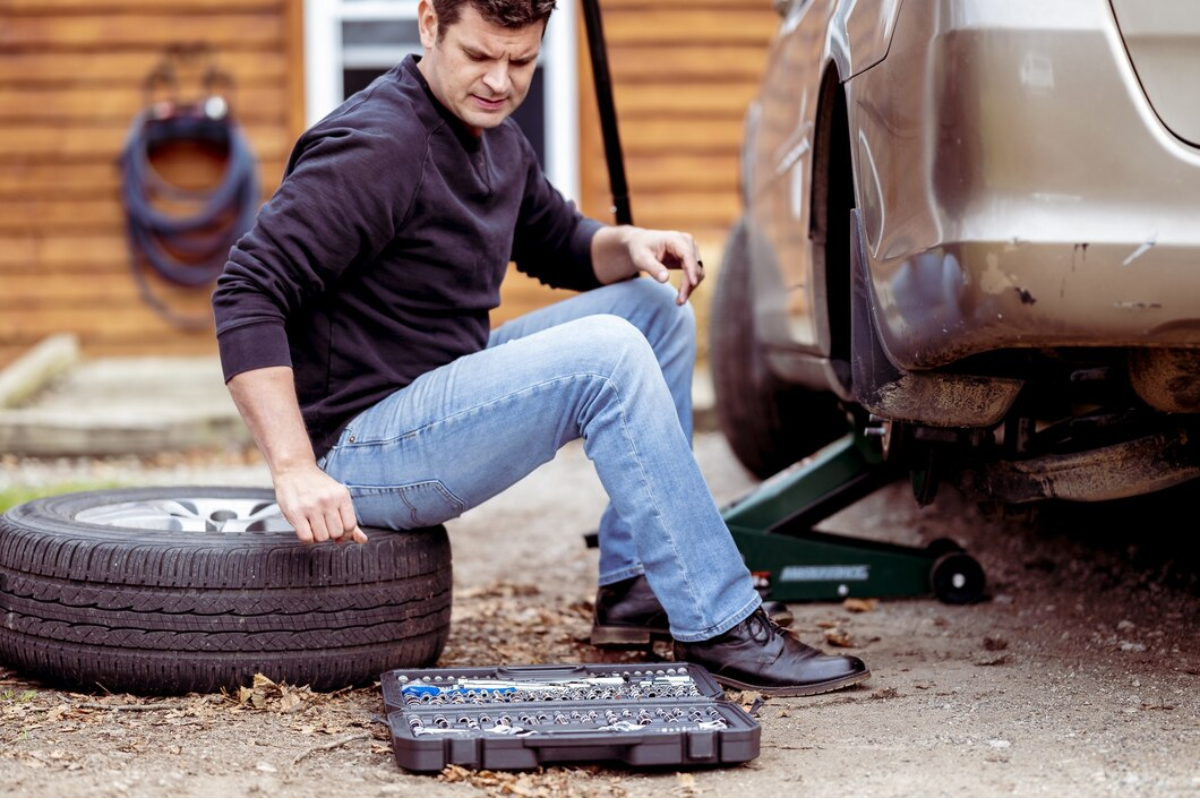Getting a flat tire can turn a smooth ride into a stressful situation. Whether you’re on your way to work, a weekend trip, or just heading to the store, knowing how to change a tire can save time, money, and hassle.
What You Should Know Before Changing a Tire?
Before grabbing the jack or wrench, it’s important to understand a few key points that will make the process smoother and safer. Not all cars are built the same — some have different jack points, spare tire types, or lug nut setups. Reading your owner’s manual ahead of time can help you get familiar with your vehicle’s specifics.
It’s also good to know what kind of spare tire your car carries. Some come with full-size spares, while others include compact “donuts” meant only for short distances. Knowing this upfront helps you make better decisions once the tire is changed.
In short, being mentally prepared and understanding your car’s setup puts you ahead of the curve when a flat tire happens unexpectedly.
Essential Tools You’ll Need
Every driver should keep a basic set of tire-changing tools in the car. You don’t need anything fancy — just the essentials that get the job done.
At the minimum, your car should include a spare tire (properly inflated), a jack, and a lug wrench. Most vehicles come with these items stored in the trunk, but it’s worth checking now instead of during an emergency.
Other helpful items include gloves to keep your hands clean, a flashlight for night-time flats, and a small wooden block or brick to help stabilize the jack on uneven ground. A tire pressure gauge can also be useful once the spare is on.
Having these tools ready not only speeds things up but also reduces stress in an already frustrating moment.
How to Find a Safe Spot to Pull Over?
When your tire goes flat, the first priority is safety — both yours and that of other drivers. Don’t slam the brakes or swerve off the road. Slow down gradually and look for a safe, level area to pull over.
Ideally, find a wide shoulder, parking lot, or rest stop. Avoid hills or soft surfaces like grass or sand, which can make jacking up the car dangerous. If it’s dark, turn on your hazard lights immediately so other drivers can see you. Stay calm and think about your visibility and stability before you begin.
If traffic is heavy or the location feels risky, it’s okay to drive slowly a short distance to a safer area. A slightly damaged tire is better than putting yourself in harm’s way.
Step-by-Step Guide to Changing a Tire
Changing a tire is a hands-on process, but you don’t need to be a mechanic to get it right. Just follow each step with care.
Loosening the Lug Nuts
Before lifting the car, loosen the lug nuts while the tire is still touching the ground. This keeps the wheel from spinning while you turn the wrench. Use your body weight if needed, pressing down with your foot to break them loose. Don’t fully remove them yet — just get them turning.
Using the Jack to Lift Your Car
Find your car’s jack point — usually behind the front wheel or in front of the rear wheel. This information is usually marked near the rocker panel or shown in the manual. Place the jack under this point and begin raising the car slowly. Make sure the car is stable as it lifts.
Raise the car just enough so the flat tire is off the ground. Don’t go higher than necessary, as it increases the risk of instability.
Swapping the Flat for the Spare
Once the tire is in the air, finish removing the loosened lug nuts and carefully pull the flat tire off. Place it to the side so it doesn’t roll away. Align the spare with the lug bolts and slide it onto the wheel hub.
Make sure the tire is sitting flush against the hub before proceeding.
Tightening Everything Back Up
Reattach the lug nuts and tighten them by hand first, crisscrossing as you go to help seat the tire evenly. Once they’re hand-tight, lower the car back to the ground using the jack.
Once the car is resting on its wheels again, finish tightening the lug nuts with the wrench, still using the crisscross pattern for even pressure.
Take a moment to double-check each nut — you don’t want a loose wheel while driving.
Checking the Spare and Cleaning Up
With the new tire on and secured, it’s time to clean up. Place your tools and flat tire back in the trunk — many compact tires are smaller, so your original wheel may not fit in the original spare space. Be mindful of that.
Check the air pressure in the spare if you can. Most spares have a recommended PSI printed on them, and it’s usually higher than a standard tire. If the pressure is low, drive cautiously and head straight to the nearest gas station or tire shop.
Also, remember that spare tires aren’t made for long-term driving. Get your flat repaired or replaced as soon as possible.
When You Shouldn’t Change the Tire Yourself?
While changing a tire is a useful skill, it’s not always the right call in every situation. If you’re on a busy highway, in extreme weather, or on unstable ground, it’s often safer to call roadside assistance.
If you’re missing tools, wearing unsafe clothing (like sandals), or unsure about the process, it’s okay to ask for help. Your safety is more important than doing it yourself.
Modern services like roadside apps or insurance hotlines can send help quickly, and that peace of mind is sometimes worth it — especially at night or in unfamiliar areas.
Tips to Avoid Getting a Flat Tire in the First Place
While some flats are unavoidable, many can be prevented with regular care. Check your tire pressure monthly and keep it within the recommended range listed on your driver-side door or in the manual. Underinflated or overinflated tires wear out faster and are more prone to failure.
Rotate your tires every 5,000–7,000 miles and inspect them for signs of damage like bulges, cracks, or uneven wear. Don’t ignore warning lights — many cars have tire pressure monitoring systems that alert you early.
Avoid potholes, debris, and curbs when possible. Also, make sure your tires aren’t past their expiration date — yes, tires age too, even if the tread looks fine.
Being proactive with tire care can help you avoid the need to learn how to change a tire on the side of the road.
Conclusion
Knowing how to change a tire gives you confidence on the road. It’s not just about saving time or money — it’s about staying calm in stressful moments and being prepared. With a little knowledge, the right tools, and a safety-first mindset, anyone can handle a flat tire without panic.
Still, if you’re unsure or in a risky situation, don’t hesitate to call for help. The goal is always to get back on the road safely.
FAQs
1. How long does it take to change a tire?
For most people, it takes 15 to 30 minutes, depending on experience and road conditions.
2. Can I change a tire without a jack?
No, a jack is essential to lift the car safely. Without it, changing the tire is nearly impossible.
3. Is it safe to drive on a spare tire for a long time?
Not really. Most spares are temporary and should only be used for short distances — ideally under 50 miles and below 50 mph.
4. What should I do if I don’t have a spare tire?
Call roadside assistance or a tow service. Some modern cars don’t include spares, so having a plan in advance is a smart move.
My name is Mustafa, and I have been blogging for over 5 years. I am passionate about sharing complete, accurate, and helpful information with my readers. Along with managing content on The Matcha Read, I also contribute blog posts to premium websites. My goal is to provide valuable insights in a clear and easy-to-understand way, so every reader walks away with useful knowledge.










